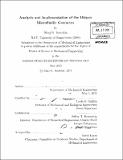Analysis and implementation of the bilayer microfluidic geometry
Author(s)
Inamdar, Niraj K
DownloadFull printable version (8.493Mb)
Other Contributors
Massachusetts Institute of Technology. Dept. of Mechanical Engineering.
Advisor
Linda G. Griffith and Jeffrey T. Borenstein.
Terms of use
Metadata
Show full item recordAbstract
Microfluidic devices form an important class of analytical platforms that have found wide use in the biomedical sciences. In particular, they have been used in cell culture systems, where they are used to monitor cell behavior in various environments. One challenge that has emerged, however, is the ability for a microfluidic device to uniformly deliver soluble factors to a given culture of cells without subjecting the cells to hydrodynamic shear stresses that could potentially alter their behavior in an unpredictable or undesirable way. This is especially true for a number of cell types, and striking a balance between solute transport and shear stress remains the subject of active research. In this thesis, we will consider a membrane bilayer device configuration in which the transport of a solute to a cell population is achieved by flowing solute through a proximate channel separated from the culture channel by a membrane and seek to characterize some of its hydrodynamic and transport characteristics. It will be shown analytically that this configuration affords greater flexibility over a more traditional single-channel setup, in terms of control over solute transport and applied shear. We will also discuss some topics related to the flow fields within such devices, as well as the fabrication and implementation of the bilayer microfluidic device in an experimental setting.
Description
Thesis (S.M.)--Massachusetts Institute of Technology, Dept. of Mechanical Engineering, 2011. Page 126 blank. Cataloged from PDF version of thesis. Includes bibliographical references (p. 121-125).
Date issued
2011Department
Massachusetts Institute of Technology. Department of Mechanical EngineeringPublisher
Massachusetts Institute of Technology
Keywords
Mechanical Engineering.